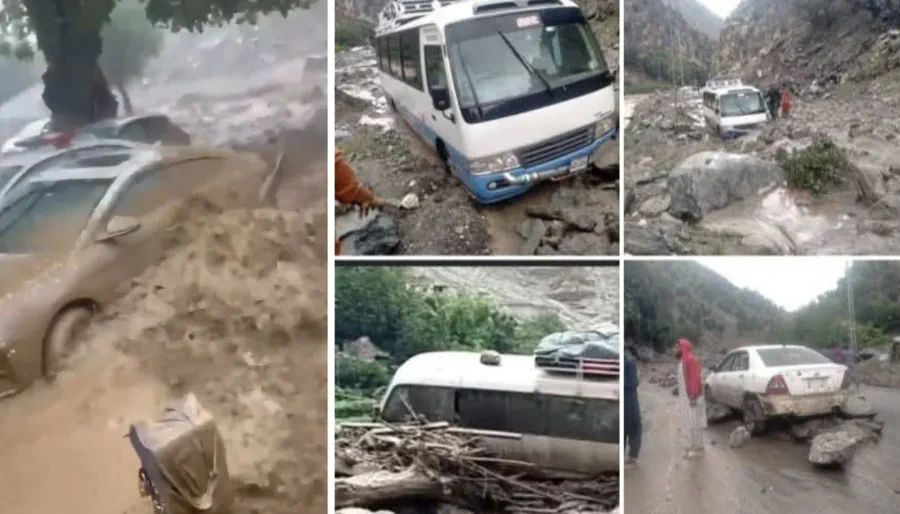Monsoon Floods in Pakistan Claim 10 More Lives as Toll Rises to 252, Fresh Alerts Issued for Northern Regions

Torrential monsoon rains continued to devastate northern Pakistan on Wednesday, claiming 10 additional lives and injuring at least six others. The latest fatalities push the nationwide death toll to 252 since the onset of heavy rains on June 26, according to the National Disaster Management Authority (NDMA). With forecasts predicting more rainfall, authorities remain on high alert for flash floods, glacial lake outburst floods (GLOFs), and landslides across multiple provinces.
Also Check: Live weather updates in Pakistan
Also Read:
The NDMA’s daily update confirmed widespread damage to homes, farmlands, and infrastructure nationwide. More than 804 houses have been damaged—many completely destroyed—while hundreds of families have been displaced. The monsoon spell, now nearing a month in duration, continues to affect major river systems, including the Indus, Chenab, Ravi, Jhelum, and Sutlej, triggering evacuations in low-lying areas and heightening fears of additional flooding.
Punjab remains the hardest-hit province, where 135 fatalities have been recorded so far. Districts like Muzaffargarh, Dera Ghazi Khan, and Rahim Yar Khan are facing mass evacuations as floodwaters from Ravi, Sutlej, Chenab, and Indus rivers submerge agricultural lands and residential neighborhoods. Crops have been destroyed in several riverine belts, raising concerns about food supply disruptions.
Urban flooding has also wreaked havoc in Lahore and Jhelum, where drainage systems failed to cope with 108mm of rainfall in a single day. A cricket stadium in Jhelum was completely inundated, while flash floods in Attock pushed stormwater into residential areas. Authorities have instructed residents in Hafizabad and nearby river catchment zones to relocate to safer areas, particularly with rising water levels in the Chenab River.
KP has witnessed severe destruction in Swat, Bajaur, Buner, and Upper Kohistan districts. Overflowing rivers such as Swat and Panjkora have washed away homes, bridges, and farmlands, isolating remote communities. The Provincial Disaster Management Authority reported multiple fatalities, including children, after roof collapses and flash flood incidents in Madyan and Sur Dheri nullah.
Access roads to numerous mountainous villages remain blocked due to landslides, forcing rescue teams to use boats and helicopters to deliver food and medical supplies. Saturated soil conditions have heightened the risk of additional landslides, prompting urgent relocation of families from hill slopes and valleys.
In GB, flash floods have devastated Danyor and Thor Nala in Chilas, damaging irrigation systems, homes, and crops. A severe flood in the Wapda Colony prompted emergency evacuations, while link roads and suspension bridges were washed away, cutting off entire communities. Rescue operations on the Babusar Highway successfully evacuated 250 stranded tourists, although 10 to 15 people remain missing.
Further south in Astore’s Bolan area, a woman died due to flooding, and multiple houses were destroyed. Authorities have issued fresh alerts for GLOF events in Upper Hunza, Ishkoman, and adjacent valleys, urging residents to move to higher ground as melting glaciers pose renewed threats.
Southern districts of Balochistan—particularly Zhob, Sherani, and Sibi—have seen streams overflow, inundating mud homes and damaging fragile road networks. Relief teams are struggling to reach these isolated regions due to poor connectivity.
In AJK, torrential rains triggered flash floods and landslides across Neelum Valley, Leepa, and Poonch. Key access routes remain blocked, isolating multiple settlements. A cloudburst in Bhimber and Sudhnoti caused two rivers to overflow, sweeping away a major bridge and cutting off nearby villages. Rescue teams are working to restore access and supply aid amid continued rainfall forecasts.
The Pakistan Meteorological Department (PMD) and NDMA have issued high alerts for potential GLOFs and landslides in GB and KP until at least July 25. Specific areas under risk include Upper and Lower Chitral, Upper Dir, Swat, Upper Kohistan, Reshun, Brep, Booni, and Darkut.
Water levels in major rivers are being closely monitored. NDMA forecasts low to moderate-level flooding at Marala, Khanki, and Qadirabad barrages on the Chenab, rising flows at Mangla on the Jhelum, and elevated levels at Tarbela, Kalabagh, Chashma, Taunsa, and Guddu barrages on the Indus. There is also heightened risk in the Kabul River near Nowshera.
Authorities have warned of flash floods in northern valleys like Shimshal, Hushe, and Saltoro, while Balochistan’s Zhob and Musakhel regions face threats from swelling seasonal streams.
Prime Minister Shehbaz Sharif has directed the NDMA, Provincial Disaster Management Authorities (PDMAs), and local administrations to accelerate rescue and relief operations. Emphasis has been placed on reopening critical highways, including the Karakoram Highway and the Naran-Babusar-Chilas route, both blocked by massive landslides.
The Prime Minister instructed the Chief Secretary of GB to ensure food, shelter, and medical aid for stranded passengers and ordered preventive measures to curb outbreaks of waterborne diseases in flood-hit areas. Municipal corporations have been directed to improve drainage and sewage systems to mitigate urban flooding risks in major cities.
Despite rescue efforts, challenges persist. Landslides continue to block key transportation routes, hampering the delivery of relief supplies to high-altitude regions. River flows remain unpredictable due to potential water discharges from Indian dams on the Beas and Sutlej rivers, which could further worsen flooding in Punjab.
Over 10 to 15 people remain unaccounted for in GB, with search operations ongoing amid difficult weather conditions. Additionally, thousands of displaced families require immediate humanitarian assistance, including food, clean drinking water, and temporary shelter.
With monsoon rains forecast to continue over the coming days, authorities remain on high alert. Disaster management agencies are coordinating closely to pre-position relief supplies, monitor river levels, and evacuate vulnerable communities. Tourists have been strongly advised to avoid mountainous and flood-prone areas until conditions stabilize after July 25.
Read all the Breaking News Live on pakistantimes.com and Get Latest English News & Updates from Pakistan Times. Follow us on Whatsapp channel for more.








